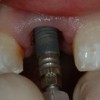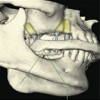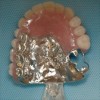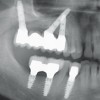The purpose of this presentation is to discuss the principles of metal-ceramic crown preparations in the posterior region. The types of finish lines employed, chamfer, shoulder, and shoulder-bevel) are described in detail, the rationale for their use, as well as the affect each of these types of finish lines have on marginal adaptation. The margin designs (metal collar, metal thinned to a fine line, and porcelain) available are described in detail as well as the affect each of these on marginal adaptation. The impact of total occlusal convergence that can reasonably be achieved, even by the most experienced clinicians, is demonstrated. The limits of tooth reduction and the need for auxillary grooves to supplement resistance form is detailed. Finally the clinical steps employed in preparing posterior teeth for metal ceramic crowns is shown in detail, including a video demonstration.
Transcript
- 1. Tooth preparation guidelines for posterior metal –ceramic crowns Charles J. Goodacre, DDS, MSD Professor of Restorative Dentistry Loma Linda University School of Dentistry This program of instruction is protected by copyright ©. No portion of this program of instruction may be reproduced, recorded or transferred by any means electronic, digital, photographic, mechanical etc., or by any information storage or retrieval system, without prior permission.
- 2. The Morphology Of Posterior Metal Ceramic Single Crowns & Fixed Partial Dentures Should Closely Simulate Natural Tooth Morphology This is only possible with adequate tooth preparation
- 3. Key Tooth Preparation Form Decisions • Finish line form (3 types have been used: chamfer; shoulder; and shoulder-bevel) • Margin design • Total occlusal convergence • Amounts and form of reduction • Need for auxiliary resistance form features
- 4. Metal Ceramic Crown Finish Lines• CHAMFER • Shoulder • Shoulder- bevel It has a continuous cervical slope that produces a decrease in reduction depth as the finish line is approached. It is formed by using a tapered round-end diamond instrument and using ½ of its tip diameter
- 5. Chamfer Finish Lines • Easy to form • Conserves cervical tooth structure • Depth decreases as finish line is approached and therefore cervical color is not as good • Well suited for crowns where a cervical collar of metal will be present
- 6. Metal Ceramic Crowns • Chamfer • SHOULDER – Round axiogingival line angle Some people call this type of finish line a heavy chamfer. Flat area lateral to rounded line angle
- 7. Shoulder with rounded axiogingival line angle was used because it is relatively easy to form and provides adequate space for an esthetic thickness of cervical porcelain.
- 8. Metal Ceramic Crowns • Chamfer • SHOULDER – Round Axiogingival Line Angle Sharp Axiogingival Line Angle Used where optimal cervical finish line depth is not possible to provide a little more space for porcelain color Used on discolored teeth where porcelain margins are needed for esthetics but the porcelain needs optimal thickness to mask the discoloration.
- 9. Shoulders with sharp axiogingival angles were used to maximize paralellism and resistance form for cantilever FPD.
- 10. Metal Ceramic Crowns • Chamfer • Shoulder • SHOULDER-BEVEL A CONCEPT HAS EXISTED FOR OVER 75 YEARS THAT BEVELED FINISH LINES MAKE CROWNS FIT BETTER
- 11. Early Results of Shoulder- Bevel Crown Fit • Metal distortion from porcelain fusion was significantly less with a shoulder-bevel (6 µm) and shoulder (10 µm) than chamfer (47 µm) and chamfer- bevel (29 µm) Shillingburg, 1973 • Metal distortion from porcelain fusion was significantly less with a shoulder-bevel (13 – 16 µm) and shoulder (15 – 19 µm) than a chamfer finish line (21 – 35 µm) Faucher, 1980
- 12. Subsequent Results Of Shoulder- Bevel Crown Fit • No significant difference in marginal distortion from porcelain fusion (shoulder, shoulder-bevel, chamfer, chamfer-bevel) Hamaguchi, 1982 • Finish line form did not affect the fit of metal ceramic crowns as a result of porcelain fusion Richter-Snapp, 1988
- 13. Subsequent Results Of Marginal Fit • With uncemented crowns, there were no significant differences between the axial and marginal fit of crowns with shoulder-bevel (32 µm), shoulder (22 µm), and chamfer (26 µm) finish lines Syu, 1993
- 14. Marginal Fit after Cementation • No significant differences in marginal fit between metal shoulder-bevel, metal shoulder, and porcelain shoulders either before or after cementation. Belser, 1985 • Finish line form does not significantly affect the fit of cemented crowns. Byrne, 1992
- 15. Metal Ceramic Finish Line Selection Is Not Based On Crown Fit. It Is Based On: • Personal preference • Formation ease: (chamfer is easiest; shoulders are harder) • Cervical crown esthetics: (shoulder provides greater porcelain thickness) • Margin design (metal or porcelain): porcelain margins require a shoulder
- 16. Key Tooth Preparation Form Decisions • Finish line form • Margin design • Total occlusal convergence • Amounts and form of reduction • Need for auxiliary resistance form features
- 17. Margin Design • Metal collar – ease of fabrication for non-visible or non-esthetic situations
- 18. Margin Design • Metal collar – ease of fabrication for non-esthetic situations • Metal thinned to a fine line that is barely visible – improved esthetics compared to metal collar but more cervical opacity than porcelain margin. Opacity has to be masked by surface coloring.
- 19. In some locations, thinning the metal collar to a fine line can work very well because there is no esthetic deficit.
- 20. Margin Design • Metal collar – ease of fabrication for non- esthetic situations. • Metal thinned to a fine line that is barely visible – improved esthetics compared to metal collar but more opacity than porcelain margin. • Porcelain (collarless metal ceramic crown) – most esthetic result but requires very skillful technician.
- 21. Metal casting opaqued Opacious dentin Dentin & Enamel applied Dentin & Enamel fired Ceramic Margin Fabrication Procedures
- 22. Ceramic Margin Fabrication Procedures Translucent enamel applied
- 23. Key Tooth Preparation Form Decisions • Finish line form • Margin design • Total occlusal convergence • Amounts and form of reduction • Need for auxiliary resistance form features
- 24. Some Textbooks & Articles Recommend 3-5° • This recommendation is not realistic because it is not an achievable number. • Only occasionally is this minimal angle achieved.
- 25. What TOC Angles Are Typically Achieved By Students? • 13.5° on dentoform teeth in laboratory • 25° during 1st clinical examination • 22° during clinical examination at the end of the senior year Weed, 1984
- 26. Additional Clinical Data Regarding Student TOC • Ohm, 1978 190 dies 19-27° • Mack, 1980 132 dies 17° • Weed, 1984 73 dies 22-25° • Noonan, 1991 909 dies 16-19° • Annerstedt, 1996 127 dies 19° • Sato, 1998 63 dies 19° • Poon, 2001 151 dies 11-26° • Al-Omari, 2004 157 dies 16-37°
- 27. • Eames, 1978 n/a 20° • Leempoel, 1987 132 dies 16-30° • Nordlander, 1988 175 dies 20° • Kent, 1988 418 dies 14° • Annerstedt, 1996 351 dies 22° What TOC Angles Are Clinically Achievable By Practitioners?
- 28. TOC Recommendations • Achievable clinical goal is 10 – 20° Excessive convergence (> 25° TOC)
- 29. Excess convergence leads to crown failure by loss of retention
- 30. Key Tooth Preparation Form Decisions • Finish line form • Margin design • Total occlusal convergence • Amounts and form of reduction • Need for auxiliary resistance form features
- 31. Finish Line Reduction Depth • There have been recommendations in textbooks and articles that finish lines should be 1.2 to 1.5 mm deep. • However, available tooth structure thickness on most teeth in young to middle age patients does not permit these reduction depths, particularly when you consider TOC.
- 32. Premolar Tooth Structure Thickness (MeanThickness at the Cervical Line) (Patient Age Range: 25-50) • Maxillary 2.4 2.5 2.2 2.3 • Mandibular 2.3 2.3 2.3 2.3 El-Hadary, 1975 Arch Facial Lingual Mesial Distal
- 33. • When a 1.2 mm deep finish line is combined with total occlusal convergence angles of 15 to 20 degrees or more, the amount of remaining tooth structure is minimal on young teeth
- 34. Maxillary Premolar Dentin Thickness & TOC (20 adolescent first premolars) • 1.2 mm deep finish line (F,L,M,D) • 5, 10, 15, 20° TOC • 1.2 mm + 20° TOC = 0.3 mm dentin • 1.2 mm + 15° TOC = 0.5 mm dentin • 1.2 mm + 10° TOC = 0.7 mm dentin Doyle, Int J Prosthodont 1990;3:241-248 REDUCTIONS THAT MEET OR EXCEED 1 mm CANNOT BE PRODUCED ON YOUNG TEETH WHERE THE PULPS ARE RELATIVELY LARGE
- 35. Data Regarding Finish Line Depth
- 36. Mean Facial Shoulder Depth • 24 extracted teeth prepared by 3 different faculty members with at least 6 years of experience. • No shoulders were within the common. recommendations of 1.2 – 1.5 mm depth • Mean depth of 0.75 mm. • Range from 0.47 to 1.1 mm. Seymour, 1996
- 37. MC Facial Shoulder Depths • Premolars – 0.7 mm mean depth • Molars – 0.8 mm mean depth Poon, Quintessence Int 2001;32:603-610
- 38. Premolar finish line depths of 0.8 mm and molar depth of 1.0 mm
- 39. • Reduction depths in excess of 1.0 mm can only be achieved on mature teeth where considerable secondary dentin formation has occurred and the pulp dimensions have been reduced. • When teeth are prepared with finish lines that actually approach or reach 1.5 mm, the teeth appear to have been compromised.
- 40. 1.4 mm1.1 mm
- 41. Key Tooth Preparation Form Decisions • Finish line form • Margin design • Total occlusal convergence • Amounts and form of reduction • Need for auxiliary resistance form features when TOC is > 25 degrees and / or prepared tooth is short (↓ OC – less than 4 mm on molars).
- 42. • When there is a need for even greater auxiliary resistance form, grooves can be added to the tooth preparation
- 43. Steps in the preparation of posterior teeth for metal-ceramic crowns: Step 1: AXIAL REDUCTION Facial, Proximal, & Lingual Surfaces
- 44. Facial Surface Reduction • Using a coarse grit diamond instrument, prepare facial depth grooves that follow the occlusoocervical curvature of the facial surface. • The depth of the grooves varies with patient age. It is recommended that the grooves be 0.8 – 1.0 mm deep in young patients and 1.0 – 1.2 mm deep in older patients. Depths of 0.8 – 1.0 may not be possible on small teeth, teeth with large pulps, and teeth where the finish line will be located apical to the cervical line. Finish line depths of 1.2 – 1.5 mm produce excessive reduction of tooth structure on most teeth.
- 45. • The use of depth grooves assures uniform reduction that enhances the esthetic result by providing uniform space for the ceramic material that overlays the metal casting.
- 46. • Select a diamond instrument with a tip diameter of about 0.8 to 1.0 mm, depending on tooth and pulp size. Prepare facial grooves until their depth matches the instrument diameter. 1 MILLIMETER TIP DIAMETER
- 47. The depth groove form should follow the occlusocervical curvature of the facial surface.
- 48. • Following the depth of the grooves, the facial surface is reduced while establishing the desired finish line. • The proximal surfaces are also reduced. • A total occlusal convergence angle of 10 – 20 degrees is established between the mesial and distal surfaces.
- 49. • When restoring the lingual and proximal surfaces with metal, reduce the lingual surface (cervical to the cingulum) while forming a 0.3 – 0.5 mm deep chamfer finish line.
- 50. • When restoring the lingual surface with porcelain, reduce the lingual surface to a depth of 0.5 – 0.8 mm • This reduced lingual surface should produce a total occlusal convergence angle of 10 to 20 degrees between the facial and lingual surfaces TOC = 10-20°
- 51. Greater faciolingual convergence is sometimes needed so crowns & FPDs can have compatible morphology with adjacent unprepared teeth that have considerable occlusal convergence to their facial & lingual surfaces. In these situations, the loss of resistance form should be compensated for by increasing the occlusocervical dimension, adding proximal grooves/boxes or both.
- 52. • Creating a somewhat abrupt transition between the deeper facial reduction and the proximal surfaces enhances resistance form by functioning like one-half of a groove when greater resistance is needed.
- 53. Step 2: REDUCTION FOR OCCLUSAL CLEARANCE
- 54. • When the occlusal surface will be restored using metal, at least 1.0 – 1.5 mm for occlusal clearance is required.
- 55. • When restoring the occlusal surface with porcelain, the reduction for occlusal clearance should be 2.0 – 2.5 mm
- 56. Porcelain coverage of the occlusal surface requires substantial reduction to have natural occlusal surface morphology.
- 57. Inadequate Occlusal Reduction Of The Left Side Molars Resulted In A Lack Of Space For Porcelain
- 58. Inadequate Central Fossa Reduction Resulted In Crown Opaqueness
- 59. Examples where adequate occlusal reduction permitted appropriate occlusal morphology
- 60. Step 3: ROUNDING / BEVELING LINE ANGLES
- 61. • Line angles should be rounded or beveled to facilitate pouring impressions without trapping air bubbles and investing wax patterns without air inclusions. • Additionally, should nodules occur in the casting, they are easier to remove when the line angles have been rounded • With CAD/CAM milled crowns, the milling tools cannot get into sharp acute angles where surfaces meet
- 62. Tooth Preparation Review • Facial reduction of 0.8 – 1.0 mm whenever possible. Depths may have to be less than 1.0 mm in younger patients. Depths of 1.2 – 1.5 mm are not usually possible cervically • A proximal and lingual chamfer of 0.3 – 0.5 mm for metal and 0.8 mm for porcelain • Uniform axial reduction that produces 10 to 20 degrees of total occlusal convergence • At least 2.0 mm of occlusal reduction is required for posterior teeth when those surfaces will be veneered with porcelain. Less reduction (1.0 -1.5 mm) can be adequate when using metal to restore occlusal contact • Line angles should be rounded
- 63. Thank You For Your Kind Attention Charles J. Goodacre, DDS, MSD Professor of Restorative Dentistry Loma Linda University School of Dentistry
- 64. v Visit ffofr.org for hundreds of additional lectures on Complete Dentures, Implant Dentistry, Removable Partial Dentures, Esthetic Dentistry and Maxillofacial Prosthetics. v The lectures are free. v Our objective is to create the best and most comprehensive online programs of instruction in Prosthodontics


 Single Tooth Defects in Posterior Quadrants
Single Tooth Defects in Posterior Quadrants
 Angled Implants
Angled Implants
 Implants and RPDs
Implants and RPDs
 Restoration of Posterior Quadrants and Treatment Planning
Restoration of Posterior Quadrants and Treatment Planning
